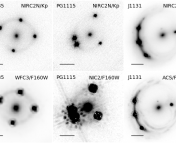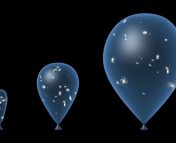Title: STRIDES: a 3.9 per cent measurement of the Hubble constant from the strong lens system DES J0408−5354
Authors: Anowar. J. Shajib, Simon Birrer, Tommaso Treu, et al.
First Author’s Institution: Department of Physics and Astronomy, University of California, Los Angeles
Status: Published in MNRAS [open access]
The Universe is growing up. But how big is it now, and how fast is it growing? Just like how pediatricians use our heights as children to predict our future heights and growth rates, astronomers can measure the expansion rate of the Universe, also known as the Hubble constant (H0), by modeling light from when the Universe was just a baby. Specifically, observations of the Cosmic Microwave Background, light emitted when the Universe was just 400,000 years old, yield a Hubble constant of about 67 km/s/Mpc (the Universe is about 14 billion years old now).
But wait! The doctor from across town just called. She measured a Hubble constant of 73 km/s/Mpc using a completely independent method that employs nearby stars called Cepheids. The debate over the conflicting values of H0 is known in astronomy as “the Hubble tension” (see this astrobite for a comprehensive review).
It’s crucial astronomers get to the bottom of this discrepancy, because the Hubble constant impacts so much of our current understanding of cosmology. For example, the Hubble constant constrains models of dark energy and the masses of neutrinos, which are extremely low-mass particles with zero charge. One solution to the tension is to measure the Hubble constant with as many different methods as possible, so we can figure out which models are incorrect. Today’s paper focuses on one such technique that capitalizes on a novel method involving gravitational lensing.
Using bending light to measure the Universe
Gravitational lensing occurs when the light rays from a faraway source are bent around a nearby massive object due to its gravitational field. The light rays from the source can end up taking different paths because of intervening mass along the line of sight and the expansion of the Universe. So to us as observers, the result is the appearance of multiple images! A cartoon of how the light from a variable source is bent around a galaxy, and subsequently appears as four images to us on Earth, is shown in Figure 1. If the source is variable, like a quasar (extremely bright objects powered by supermassive black holes), then the different images of the same source appear not only at different places, but also at different times, delayed relative to one another because of the different paths the light takes (hence “time delay”). Cosmologists have figured out a neat trick– the time delay is proportional to, and can be used to infer, the Hubble constant. This method of inference for measuring H0 is called time-delay cosmography, which is a fancy phrase for using measured time delays to probe the size and characteristics of the Universe.
DES J0408-5354: the first multiple-source system used to measure H0
This paper uses Hubble Space Telescope (HST) imaging of a strong lensing system, DES J0408-5354, shown in Figure 2. This lens system is unique because it has multiple sources (i.e., the quasar (images ABCD), S2, and S3 in Figure 2), where previously studied lensing systems had only contained one light source. This paper also tackles one of the main issues currently facing time-delay cosmography: modeling the distribution of the mass doing the lensing, which the value of the Hubble constant is highly dependent upon. The fact that this lens system has multiple sources makes it even more difficult to model, which is why the success of this paper was so ground-breaking. To also help prevent bias affecting the modeling, the authors use a technique called blind analysis, where the authors avoided looking at the results until the end.
The authors end up measuring a Hubble constant value of H0 = 74.2 km/s/Mpc, with a 3.9% uncertainty, shown in Figure 3. This number is currently in line with measurements from the Cepheid stars, but the authors hope to eventually reach 1% uncertainty with improved modeling software and more lens systems. In the modern era of precision cosmology, we’re getting a clearer picture of what our Universe will look like when it’s all grown up.
Astrobite edited by Evan Lewis and Wynn Jacobson-Galan
Featured image credit: Amazon




